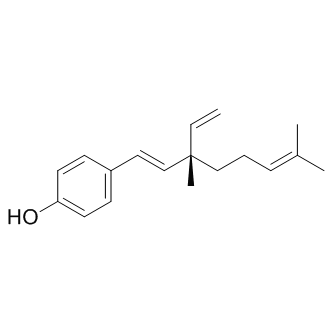| Cas No.: | 10309-37-2 |
| SMILES: | C[C@](CC/C=C(C)C)(C=C)/C=C/C1=CC=C(O)C=C1 |
| Formula: | C18H24O |
| M.Wt: | 256.38 |
| Purity: | >98%, Standard References Grade |
| Sotrage: | 4°C for 1 year, -20°C for more than 2 years |
| Description: | Bakuchiol is a phytoestrogen isolated from the seeds of Psoralea corylifolia L; has anti-tumor effects |
| In Vivo: | In combination with the reported concentration after an intravenous administration of bakuchiol (15 mg/kg) in rats, the high risk of in vivo inhibition of bakuchiol towards UGT2B7-catalyzed metabolism of drugs was indicated [2]. In a guinea pig model of tinea pedis, bakuchiol at 1%, 5% or 10% (w/w) concentration in aqueous cream could significantly reduce the fungal burden of infected feet (p<0.01-0.05) [4]. |
| In Vitro: | Bakuchiol reduced mitochondrial membrane potential (Psim) of cells in a concentration- and time-dependent manner, showing a more potent effect than that of resveratrol. S phase arrest, caspase 9/3 activaton, p53 and Bax up-regulation, as well as Bcl-2 down-regulation were observed in bakuchiol-treated A549 cells [1]. UGT2B7 was inhibited by the strongest intensity. The noncompetitive inhibition was demonstrated by the results obtained from Dixon plot and Lineweaver-Burk plot. The Ki value was calculated to be 10.7 μM [2]. Bakuchiol was found to be naturally occurring potent inhibitors of hCE2, with low Ki values ranging from 0.62μM to 3.89μM [3]. After exposure to bakuchiol at 0.25-fold, 0.5-fold and 1-fold of minimum inhibitory concentration (MIC) (3.91 μg/ml) for 24h, the fungal conidia of T. mentagrophytes demonstrated a significant dose-dependent increase in membrane permeability. Moreover, bakuchiol at 1-fold MIC elicited a 187% elevation in reactive oxygen species (ROS) level in fungal cells after a 3-h incubation [4] |
| References: | [1]. Chen Z, et al. Anti-tumor effects of bakuchiol, an analogue of resveratrol, on human lung adenocarcinoma A549 cell line. Eur J Pharmacol. 2010 Sep 25;643(2-3):170-9. [2]. Xu Y, et al. In vitro evidence for bakuchiol's influence towards drug metabolism through inhibition of UDP-glucuronosyltransferase (UGT) 2B7. Afr Health Sci. 2014 Sep;14(3):564-9. [3]. Li YG, et al. Fructus Psoraleae contains natural compounds with potent inhibitory effects towards human carboxylesterase 2. Fitoterapia. 2015 Jan 13;101C:99-106. [4]. Lau KM, et al. Anti-dermatophytic activity of bakuchiol: in vitro mechanistic studies and in vivo tinea pedis-inhibiting activity in a guinea pig model. Phytomedicine. 2014 Jun 15;21(7):942-5. |

 DC Chemicals' products qualify for U.S. tariff exemptions. We guarantee no price increases due to customs duties and maintain stable supply, continuing to deliver reliable research solutions to our American clients.
DC Chemicals' products qualify for U.S. tariff exemptions. We guarantee no price increases due to customs duties and maintain stable supply, continuing to deliver reliable research solutions to our American clients.





















